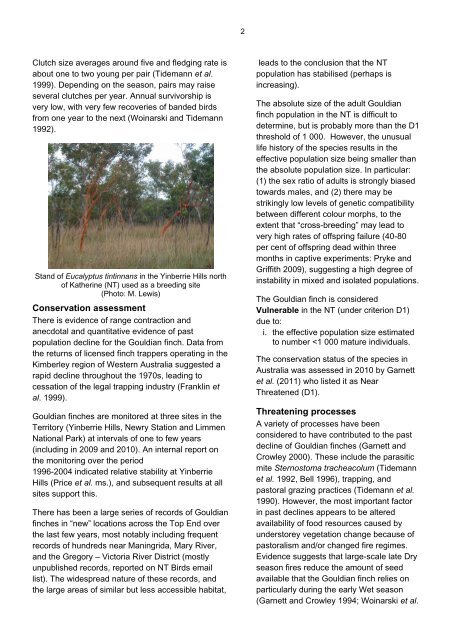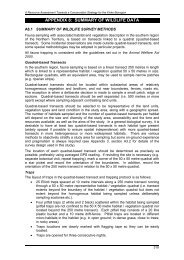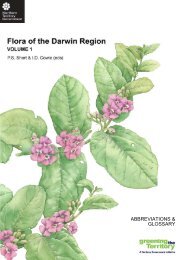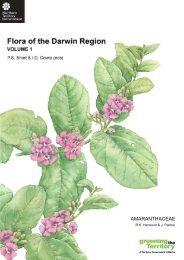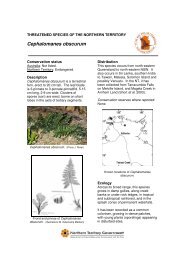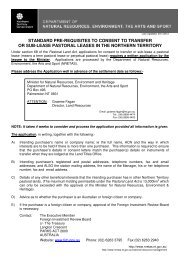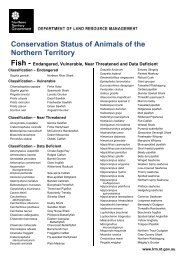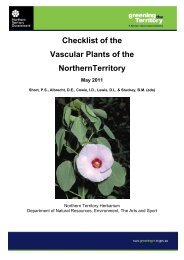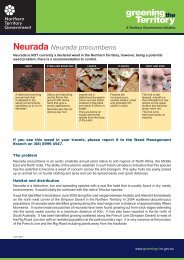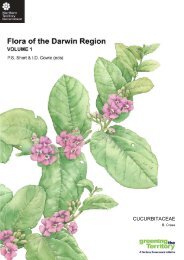GOULDIAN FINCH Erythrura gouldiae - Department of Land ...
GOULDIAN FINCH Erythrura gouldiae - Department of Land ...
GOULDIAN FINCH Erythrura gouldiae - Department of Land ...
Create successful ePaper yourself
Turn your PDF publications into a flip-book with our unique Google optimized e-Paper software.
Clutch size averages around five and fledging rate is<br />
about one to two young per pair (Tidemann et al.<br />
1999). Depending on the season, pairs may raise<br />
several clutches per year. Annual survivorship is<br />
very low, with very few recoveries <strong>of</strong> banded birds<br />
from one year to the next (Woinarski and Tidemann<br />
1992).<br />
Stand <strong>of</strong> Eucalyptus tintinnans in the Yinberrie Hills north<br />
<strong>of</strong> Katherine (NT) used as a breeding site<br />
(Photo: M. Lewis)<br />
Conservation assessment<br />
There is evidence <strong>of</strong> range contraction and<br />
anecdotal and quantitative evidence <strong>of</strong> past<br />
population decline for the Gouldian finch. Data from<br />
the returns <strong>of</strong> licensed finch trappers operating in the<br />
Kimberley region <strong>of</strong> Western Australia suggested a<br />
rapid decline throughout the 1970s, leading to<br />
cessation <strong>of</strong> the legal trapping industry (Franklin et<br />
al. 1999).<br />
Gouldian finches are monitored at three sites in the<br />
Territory (Yinberrie Hills, Newry Station and Limmen<br />
National Park) at intervals <strong>of</strong> one to few years<br />
(including in 2009 and 2010). An internal report on<br />
the monitoring over the period<br />
1996-2004 indicated relative stability at Yinberrie<br />
Hills (Price et al. ms.), and subsequent results at all<br />
sites support this.<br />
There has been a large series <strong>of</strong> records <strong>of</strong> Gouldian<br />
finches in “new” locations across the Top End over<br />
the last few years, most notably including frequent<br />
records <strong>of</strong> hundreds near Maningrida, Mary River,<br />
and the Gregory – Victoria River District (mostly<br />
unpublished records, reported on NT Birds email<br />
list). The widespread nature <strong>of</strong> these records, and<br />
the large areas <strong>of</strong> similar but less accessible habitat,<br />
2<br />
leads to the conclusion that the NT<br />
population has stabilised (perhaps is<br />
increasing).<br />
The absolute size <strong>of</strong> the adult Gouldian<br />
finch population in the NT is difficult to<br />
determine, but is probably more than the D1<br />
threshold <strong>of</strong> 1 000. However, the unusual<br />
life history <strong>of</strong> the species results in the<br />
effective population size being smaller than<br />
the absolute population size. In particular:<br />
(1) the sex ratio <strong>of</strong> adults is strongly biased<br />
towards males, and (2) there may be<br />
strikingly low levels <strong>of</strong> genetic compatibility<br />
between different colour morphs, to the<br />
extent that “cross-breeding” may lead to<br />
very high rates <strong>of</strong> <strong>of</strong>fspring failure (40-80<br />
per cent <strong>of</strong> <strong>of</strong>fspring dead within three<br />
months in captive experiments: Pryke and<br />
Griffith 2009), suggesting a high degree <strong>of</strong><br />
instability in mixed and isolated populations.<br />
The Gouldian finch is considered<br />
Vulnerable in the NT (under criterion D1)<br />
due to:<br />
i. the effective population size estimated<br />
to number


